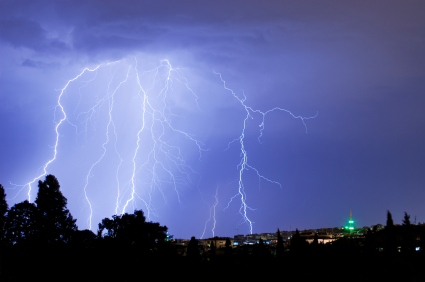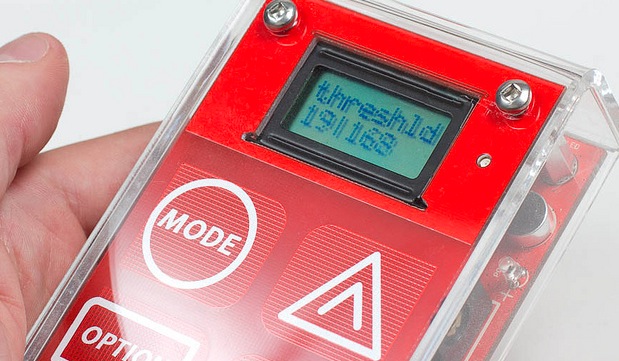
The most frequently requested feature on the Triggertrap is a deceptively simple question with a wickedly complicated answer: “Can the Triggertrap be used to photograph Lightning”. I’ve spent a lot of time thinking about this one, because it’s not as easy to answer as you’d think.
 The problem is that cameras are not as fast as you would like. No matter how fast the Triggertrap reacts, an SLR camera has to do several things before it is ready to take a photo: Flip the mirror out of the way, and open a shutter curtain, among other things. These things don’t take a lot of time, I’ll grant you, but it’s not for nothing that “fast as lightning” is a pretty standard expression. Lightning is fast. Very, very fast.
The problem is that cameras are not as fast as you would like. No matter how fast the Triggertrap reacts, an SLR camera has to do several things before it is ready to take a photo: Flip the mirror out of the way, and open a shutter curtain, among other things. These things don’t take a lot of time, I’ll grant you, but it’s not for nothing that “fast as lightning” is a pretty standard expression. Lightning is fast. Very, very fast.
The Triggertrap unversal camera trigger is also very, very fast – much faster than your camera, in fact. It can react in about 2 milliseconds, which makes it fast enough to use it as a slave flash trigger. However, only a flash reacts quickly enough to the Triggertrap; a camera will always have a delay. And I probably don’t have to mention that there’s no point in trying to trigger a flash in response to lightning: we have light a-plenty, but what we really want, is to get the camera to trigger.
Enter the Triggertrap: Taking luck out of the equation.
My standard method of taking photos of lightning is basically to dial in a long shutter speed (10 seconds, perhaps), and then just hold down the shutter button and cross my fingers. Eventually, you’re bound to get lucky, and get a beautiful lightning photograph.
Of course, the ‘spray and pray’ approach has its problems: There are short periods of time between exposures where you aren’t taking photos, and it’s sod’s law that that’s exactly when your lightning will strike. This gets more complicated as well if you are shooting in raw (and you should…), because depending on your shutter speed, you might find yourself running into problems with your buffer filling etc. Anyway, if we plot this approach on a graph, we get something like this:
So, how can you hedge your bets? Well, it’s simple: Use two cameras, and trigger them alternately. It’s pretty easy to do this using some electronics; set a timer, and make sure the cameras alternate:
No gaps! That's an improvement.
Of course, that still isn’t perfect; as we already discussed, cameras have tiny delays between shots, and if you trigger them electronically, there would in theory be no gaps. In practice, however, there are going to be times when one camera is closing its shutter, and the other one is still flipping up its mirror, and you’d still be missing your photographs. Useless!
The next logical step, then, is to make sure they overlap a little:
Ah! That's better!
Now, every milisecond of the thunderstorm would be captured; and we’d even have a tiny little bit of overlap for good measure. Fabulous.
Adapting the Triggertrap
“But Haje”, I hear you cry. “The Triggertrap only has one camera port, how are you going to get around that one?!”
Well, true, it does only have one camera port, but it does actually have two triggers built in: The Focus and the Shutter triggers. If we decide that we don’t need the ‘focus’ trigger (because we’ve pre-focused our cameras”, that frees up one of the triggers. All you’d have to do then is to create a cable that enables you to plug in two Triggertrap cables into the same Triggertrap. Easy:
By using 3.5mm sockets, you can continue to use the Triggertrap cables you already have; plug it directly into the Triggertrap to use it as normal, and plug it into the above-described gadget to split the signal so you can plug in two cameras.
The rest is all software
By overlapping the shots, you can guarantee to capture whatever is happening in the night sky; whether it's star-trails, a meteor shower, a lightning storm, or anything else you can think of!
The Triggetrap doesn’t have a Lightning mode built in, but it is fully Arduino compatible, and as soon as we get a final version of the software, we’ll open up our Github repository and open-source the code so you can hack it to your heart’s content.
Since we haven’t yet got a final version of the code, I’m not going to post my hacks here (yet! I’ll do it as a proper tutorial once we have a final release version of our source-code) – but you’ll be pleased to know that it didn’t take me very long to get a working version of the Triggertrap Lightning Trigger to work.
Now all I need is a lightning storm so I can test it properly…
Learn More
To learn more about the Triggertrap, check out Triggertrap.com. If you want one, try the Triggertrap Shop!
